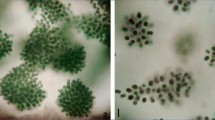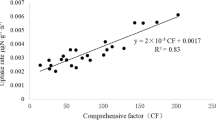Abstract
Pythium fluminum produced zoospores most abundantly at 15°C, whereas the optima forPythium ‘group F’ andP. marsipium were 20 and 25°C, respectively. Increasing the incubation temperature above the optimum resulted in the decrease of the duration of zoospore production. InPythium ‘group F’ the ability to produce zoospores was not lost even after incubation at 40°C for 24 h. On the other hand,P. marsipium andP. fluminum lost the ability under these conditions. Zoospore production was inhibited at pH 4.5 and 10.5 in all the species tested.Pythium fluminum andP. marsipium were found to have two pH optima for zoospore production (7.5 and 9.5 for the former and 5.5 and 8.5 for the latter). The optimum pH for zoospore production byPythium ‘group F’ was 6.5–7.5. Moderate osmotic potentials (−0.27∼−0.47 MPa) appeared to favor zoospore production by the pythia tested. The effect of temperature, pH and osmotic potential on zoospore production was discussed in relation to pollution of pond water.
Similar content being viewed by others
Literature cited
Abdelzaher, H. M. A., Ichitani, T. and Elnaghy, M.A. 1993. Effect of temperature, hydrogen-ion concentration and osmotic potential on oospore germination of five aquaticPythium spp. Trans. Nishi-Nippon Div. (Mycol. Soc. Japan). p. 3.
Abdelzaher, H. M. A., Ichitani, T. and Elnaghy, M.A. 1994a.Pythium fluminum var.fluminum from pond water in Osaka. Mycol. Res.98: 982–984.
Abdelzaher, H. M. A., Ichitani, T. and Elnaghy, M. A. 1994b.Pythium marsipium from pond water in Osaka, Mycol. Res.98: 920–922.
Emerson, R. 1958. Mycological organization. Mycologia50: 589–621.
Harvey, J.V. 1952. Relationship of aquatic fungi to water pollution. Sewage and Industrial Wastes24: 1159–1164.
Park, D. 1975. A cellulolytic pythiaceous fungus. Trans. Br. Mycol. Soc.65: 249–257.
Park, D. 1977.Pythium fluminum sp. nov. with one variety andP. uladhum sp. nov. from cellulose in fresh-water habitats. Trans. Br. Mycol. Soc.69: 225–231.
Pittis, J. E. and Colhoun, J. 1984. Isolation and identification of pythiaceous fungi from irrigation water and their pathogenicity of Antirrhinum, tomato andChamaecyparis lawsoniana. Phytopath. Z.110: 301–318.
Plaats-Niterink, A. J. Van der. 1981. Monograph of the genusPythium. Stud. Mycol.21: 1–242.
Singleton, L. L., Mihail, J. D. and Rush, C. M. 1992. “Methods for Research on Soilborne Phytopathogenic Fungi,” p. 255. APS Press, St. Paul.
Saleem, S. and Dick, M. W. 1990. Effect of different natural baits on zoospore and oospore production by twoPythium species. Pak. J. Bot.22: 125–128.
Suzuki, S. 1960. The seasonal variation of aquatic fungi in Senshun-ike pond. J. Loimnology (Japan)21: 271–278.
Suzuki, S. 1961. Ecological studies on the genusPythium (aquatic fungi) in Japanese lakes. Jpn. J. Ecol.11: 91–93.
Tomlinson, J. A. 1958a. Crook root of watercress. I. Field assessment of the disease and the role of calcium bicarbonate. Ann. Appl. Biol.46: 593–607.
Tomlinson, J.A. 1958b. Crook root of watercress. III. The casual organismSpongospora subterranea (Wallr.) Lagerh. F. sp.nasturtii f. sp. nov. Trans. Br. Mycol. Soc.41: 491–498.
Waterhouse, G. M. 1967. Key toPythium Pringsheim. Mycol. Pap.109: 1–15.
Webster, J. and Dennis, C. 1967. A technique for obtaining zoospores inPythium middletonii. Trans. Br. Mycol. Soc.50: 329–331.
Author information
Authors and Affiliations
About this article
Cite this article
Abdelzaher, H.M.A., Ichitani, T. & Elnaghy, M.A. Effect of temperature, hydrogen ion concentration and osmotic potential on zoospore production by threePythium species isolated from pond water. Mycoscience 35, 377–382 (1994). https://doi.org/10.1007/BF02268508
Accepted:
Issue Date:
DOI: https://doi.org/10.1007/BF02268508




